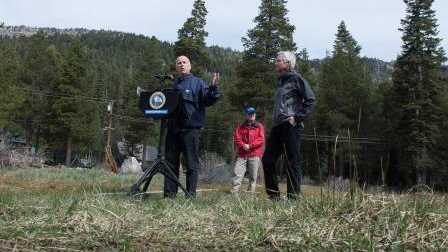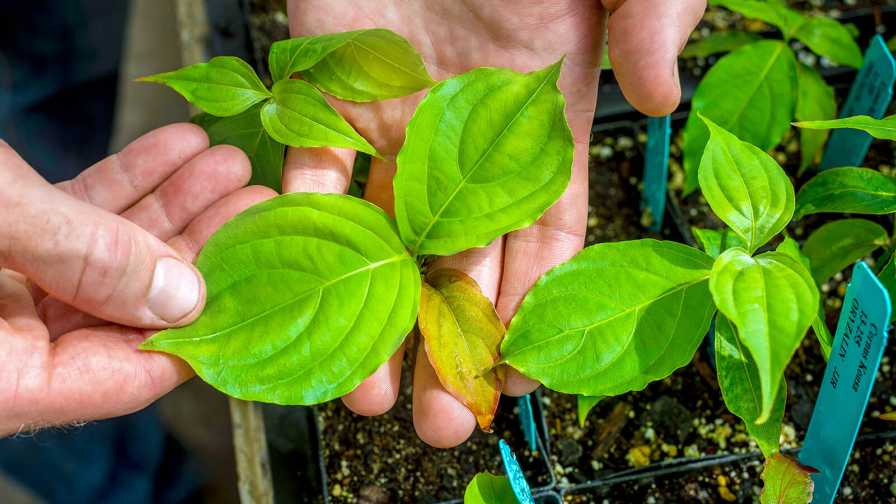California Institutes First Ever Statewide Mandatory Water Restrictions

California Gov. Jerry Brown delivers remarks. Photo Credit: California Department of Water Resources
California Gov. Jerry Brown announced April 1 that, for the first time in state history, action will be taken to implement mandatory water restrictions.
The Governor has directed the State Water Resources Control Board to institute the reductions in cities and towns across the state to reduce water usage by 25 percent. The annoucement comes following the lowest snowpack ever recorded in the High Sierra.
“Today we are standing on dry grass where there should be five feet of snow. This historic drought demands unprecedented action,” Brown said at the announcement, which took place on a mountain near Lake Tahoe. “As Californians, we must pull together and save water in every way possible.”
The reductions will save approximitely 1.5 million acre-feet of water over the next nine months. Some of the other water-saving measures include:
- Replacing 50 million square feet of lawns with drought-tolerant landscaping in partnership with local governments;
- Directing the creation of a temporary consumer rebate program to replace old appliances with more water and energy efficient models;
- Requiring campuses, golf courses, cemetaries and other large landscapes to make cuts in water use;
- Prohibiting new homes and developments from irrigating with potable water unless water-efficient drip irrigation systems are used, and ban watering of ornamental grass on public street medians.
The executive order also calls for increased enforcement, streamlined government response and investment in new technologies.
Increased enforcement will include requiring local water agencies to adjust their rate structures to implement conservation pricing, and requiring agricultural water users to report more water use information to state regulators. For more details about the executive order, read the Governor’s full release at Gov.ca.gov.
According to Doug Parker, director of the California Institute for Water Resources, the water reductions might not have a direct impact on water supply for those in the horticulture industry, as the requirements are focused more on residential and municipal water uses.
“If anything, it’s going to change the demand side,” Parker says.
Parker hopes the water reductions will change consumers’ attitudes toward what types of plants they have in their landscape, and he believes it could further increase demand for drought tolerant products.
“If the government does call for the removal of 50 million square feet of turf, hopefully it gets people to really look at their landscaping,” Parker says. “That could be a major impact, all of that has to be re-lanscaped some way.”
The ban on watering of grasses on public street medians, as well as the requirement to develop new homes with water-efficient drip irrigation systems will likely have an effect on the industry, as well.
“Certainly, growers need to be thinking long-term,” Parker says.
Many retailers in the state have already been taking action.
Roger’s Gardens in Corona Del Mar, Calif. has a multi-faceted public water education program, a successful California Friendly Gardening contest and numerous instructional videos and blogs. Its store landscape was converted to low-water California-friendly plants almost ten years ago, as well as being converted to weather-sensitive SMART irrigation, low-volume spray heads and zero-runoff irrigation.
Following the Governor’s announcement, Armstrong Garden Centers in California sent an email to its customers encouraging them to follow its water-saving tips, which include using mulch, watering deeper, but less often, using trigger sprayers and watering in the morning, to name a few.
According to the email, Armstrong Garden Centers’ experts are available to customers to demonstrate how to have a healthier garden and landscape by watering less, but more effectively, and within compliance of current watering regulations.
Water Cuts Will Affect Different Regions In Different Ways
Parker also emphasized that growers in different parts of the state will face different cuts, and those areas that have already done a good job of conserving won’t face as drastic of a reduction. For example, the San Diego area has multiple water sources, and a new desalination plan is in the works.
“San Diego is in a unique situation where we have diversified sources of water, not the single dependency much of the state has relying solely on the State Water Project that exports water from the Sacramento Delta,” says Eric Larson, executive director of the San Diego County Farm Bureau. “It is that limited source that is causing so much concern for the state.”
In San Diego County, there is water from the Colorado River, massive transfers of water from the Imperial Irrigation District, recycled water (which several large nurseries in the county use), and the desalination plant in Carlsbad, which will come online later this year.
Even with those alternate supplies, Larson says they are not immune from what is going on, and municipal and residential water users will have to follow the governor’s use restrictions.
“Even with the alternate supplies we have, I expect the retail water agencies here to aim for 25 percent savings by municipal and residential users in a show of solidarity with the entire state,” he says. “That will be good politically as well because there are occasional complaints about us importing water from other regions of the state, so we need to be a good partner.”









